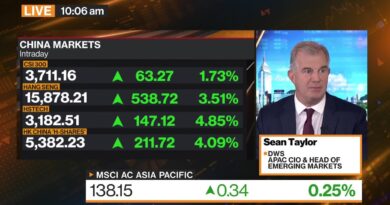The Latin American mining industry’s role in a changing copper market
Copper demand will continue to grow, and Latin America will play a more important role as China’s participation is projected to fall.
Latin America supplies about 25% of critical minerals to the world market, with copper the No. 1 commodity. But to achieve net zero by 2050, regional copper production – and recycling – must increase, according to a report by Latin American energy organization OLADE.
On the sidelines of the World Copper Conference, hosted by consulting firm CRU in Santiago, BNamericas talked to Colin Bennett, market intelligence director at the International Copper Association, to learn more about the impact of Chile’s falling output and the closure of Cobre Panamá, as well as Africa’s industry.
BNamericas: What are the main copper products required for the global energy transition by 2050?
Bennett: There’s a lot of demand around the green energy transition and from things like renewables, EVs and EV infrastructure. But power grids are growing a lot. At the moment, there’s a global demand of about 200,000t, which will grow to around 2.2Mt/y in 2040. That’s a 19% CAGR growth.
China is building a lot of grids, and that kind of growth will reach countries where they’re having to build out the networks for renewable energies. That will grow massively. That’s very good for copper because new power cables in the new equipment are required.
Those are the big growth areas, and the traditional markets like plumbing will not grow very much, but they’ll be pretty stable.
BNamericas: What impact does the recycling industry have on the copper market?
Bennett: If there’s a demand of 30Mt this year, 10Mt will come from recycled material. Copper is used in buildings and homes and mobile phones, so on one side, it is in use for 60 or 80 years and on the other for a few years. There isn’t a lot of recycled material coming back. It’s not like aluminum or other fast-moving metals.
Everybody wants recycled materials too. Authorities have put into place regulations to recycle vehicle batteries, and that could be one success story for recycling. But the truth is that you need two-thirds of the demand to be met by virgin material, like from mining.
BNamericas: How long will it take until recycled material will become significant?
Bennett: It will probably take a very long time because you need the resources to recycle, and everybody needs to recycle. Getting those two together is tough because nobody wants to invest in capacity if there isn’t a guaranteed stream of recycled material. It takes a public change.
All of our old mobile telephones need to go in. But also the collection and sorting of items with copper inside needs to improve. Everything you can think of that’s got copper needs to be collected and recycled.
The [original equipment manufacturers], for example, car manufacturers, want recycled material for the copper items used in a car. Trying to meet that [demand] is the big challenge. For some things, you can do it, but for most, you can’t because you’ve only got a certain amount of recycled material coming in. So not everybody can have the recycled material they would like.
BNamericas: Given that Chile is the biggest global producer, how much did last year’s fall in its copper output affect the market?
Bennett: In the mining industry, the balance is normally okay at the end of the year. So, there might be a dip in the first quarter, but in the fourth quarter, it’s smoothed out. There is a kind of reliability in supply. I don’t think there’s ever been a year where there’s been drastic numbers that have stuck. [Chile’s] still producing as much as it can.
There are capacity increases and planned capacity increases. Even issues with the labor force tend to last only a short time. It’s a steady and long-term market.
BNamericas: What do you think of the closure of the Cobre Panamá mine?
Bennett: It’s the wrong direction, but the market will absorb it. There will just be more demand from somewhere else to fill the gap. Then, I suppose, just wait until the issues in Panama are resolved, and it will return in the future.
In the long term, that’s probably fine. Coming back would just bolster supply then, although it’s quite big. Then, miners get their opportunity to roll out their normal strategy.
BNamericas: The Democratic Republic of the Congo is increasing its copper production, approaching Peru as the second-biggest global producer.
Bennett: A lot of Africa is a growing powerhouse, but they need their copper infrastructure for electricity and are coming through mining, which also makes money internally. There’s a lot of market research or market intelligence that needs to be done to understand the African market.
China is very involved in production around Africa. They have been making big investments in Africa’s growth. It’s a tricky market in that way.
We’re moving forward critically because copper is really a strategic material that needs to be traded between countries in Europe that don’t have copper mining. There’s no critical element like shutting the borders and consuming your own amount.
Africa has a lot of artisanal mining that is adopted, which is something that they will have to clean up if they really want to work on a global scale.
But there isn’t a shortage of copper. We haven’t come to the point where copper is scarce. Perhaps that is partly because governments have not invested enough, for example, in renewable energy and electric vehicles. It’s more about business deals. There are problems and closures, but in the end, the market balances itself somehow.
BNamericas: How real is the threat posed by aluminum as a substitute for copper as an electrical conductor?
Bennett: Substitution is about one-quarter percent of the copper market. It’s maybe 200,000t a year, and the market size is about 30Mt, so it’s really small.
There has been no big change in materials. The only example of a fixed change in copper is when plastic pipes came along and replaced copper tubing. So, the copper plumbing tube market was hit because of a new technology. But there aren’t any new technologies that are amazingly better than copper. Copper is still the preferred material.
On the other hand, there is also minimization, where society wants everything to be smaller so it can use less material.
BNamericas: What do you think about copper mining in Latin America with respect to supply and production growth?
Bennett: Any new production coming onto the market is good as long as it’s responsibly sourced. But, for example, the volume of production from Africa is still relatively small, but the percentage of growth is higher. So, it’s contributing quite a lot.
In Chile and other countries, it’s very hard to extend mines or even get permitting licenses. So, any production is welcome. Governments need to be more committed and aligned so that miners can make big investments, but with the assurance that in the future, they will not have problems extending the mines and incorporating technologies.
BNamericas: What are the copper price perspectives in the short or medium term?
Bennett: I can’t talk about price. But what I can say is that nowadays, for example, if you have an offshore wind system, the important element is no longer the cost but how efficient it is. Cost is now not a main driver of copper substitution. Price is important, but it’s gone down to sort of midway between the importance of drivers.
When you’re creating systems, you can’t skimp on materials because they need to be as efficient as possible. That doesn’t mean copper can’t substitute something in some designs, but the consideration isn’t really about cost.
Basically, it’s about efficiency and longevity. Wind turbines last around five years. You might say that you need really reliable cabling under the sea so you don’t have to touch it. So you choose copper. That kind of thing’s driving the market rather than the relative material cost that is really low.



